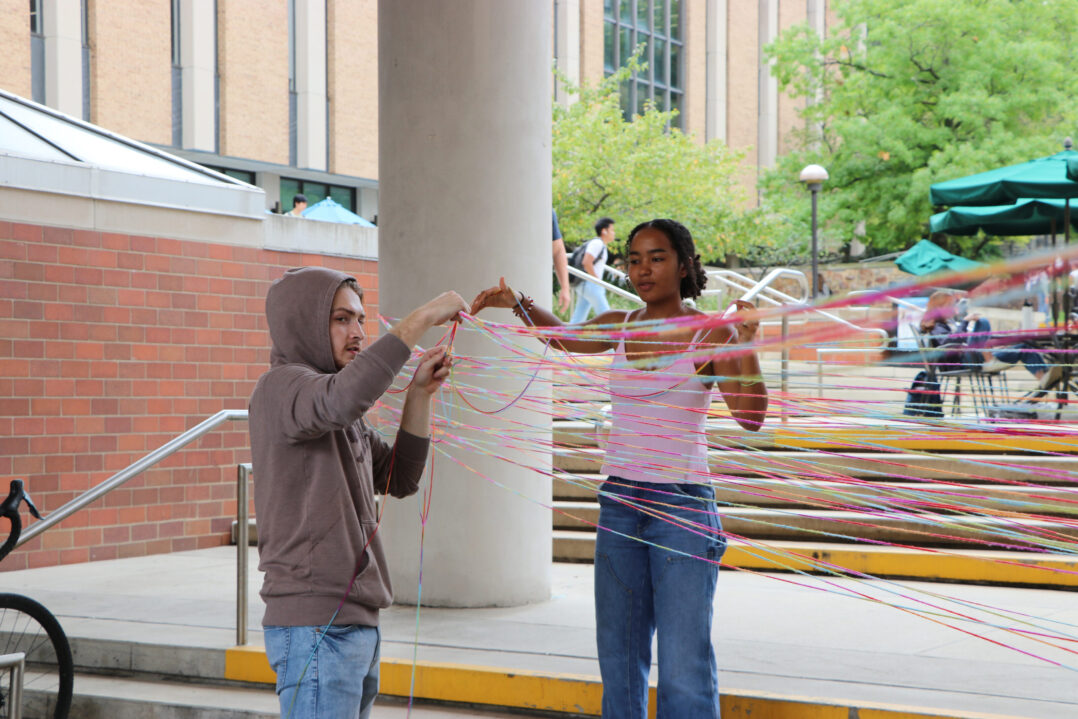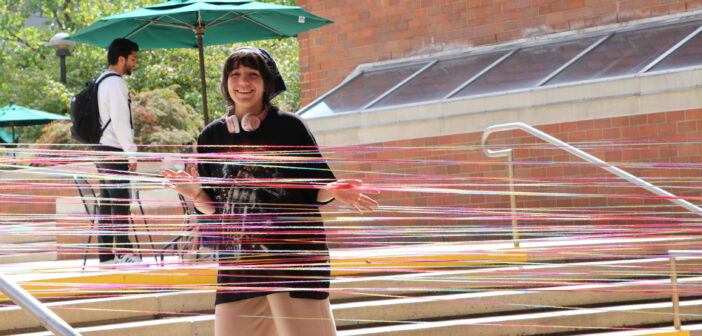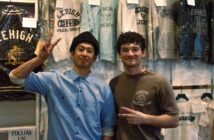In 1981, artist Richard Serra stirred up controversy with a 120-foot-long plate of steel in Foley Federal Plaza in Manhattan — an installation he called “The Titled Arc.”
Design major Norah Sanoury, ‘22, said Serra’s work inspired the experiential pop-up string art installation she created in September.

Students’ paths were disrupted by a pop-up string art installation from Sept. 12 to 15. This temporary art installment was a project By Norah Sanoury, ’22, for a class called The Art of Sites and Communities. (Photo courtesy of Norah Sanoury ‘22)
Installed near Fairchild-Martindale Library, the display intentionally inconvenienced the Lehigh community.
As students crossed through a high-traffic area near FML from Sept. 12-15, their paths were disrupted by Sanoury’s art.
This temporary art installment was an assignment for a class called The Art of Sites and Communities. The class is taught by Shimon Attie, Lehigh’s current Horger Artist in Residence, who recently unveiled his project ‘Starstruck: An American Tale’ at Zoellner Arts Center.
“We’re learning about how people have done it in the past and how we ourselves can create art that involves communities, physical locations and social issues,” Sanoury said. “The assignment itself was creating a physical installation focusing on the experiential. How can you change someone’s daily experience? If you walk one way every day, specifically for my project, how can I make that not the same?”
She said Serra’s installation in New York was seen as a nuisance to those who were disrupted by it. Sanoury was inspired by this to mimic the project herself.
“I just thought it was funny that people were complaining so much about having to walk around it when it was just a slight inconvenience,” Sanoury said. “I thought that I could introduce some sort of slight inconvenience on campus.”
Sanoury said after being up for only a few hours, the string project provoked a frustrated reaction similar to the artwork that inspired it when someone tried to personally remove it.
She said a student tried to take down the installation, thinking it was an act of vandalism.
The temporary destruction did not ruin the project entirely. After having to reassemble some of the strings that had been cut, the project stayed up and intact for several days.
The unexpected nature of this project caught most students off guard.
“There was no sign, so I couldn’t tell if it was supposed to be there or if it was Lehigh sanctioned,” Margaret Courtney, ‘25, said.
Courtney said she understood the installation had a purpose, but was not able to fully understand the meaning of it.

Design major Norah Sanoury, ‘22, created an external pop-up string art installation outside of Fairchild-Martindale Library to intentionally inconvenience Lehigh students. Sanoury’s installation was inspired by Richard Serra’s controversial art installation called “The Tilted Arc” in 1981. (Photo courtesy of Norah Sanoury ‘22)
Sanoury said she anticipated this confused reaction.
“It wouldn’t have been the same if everyone was expecting some art installation to be built there,” she said. “It’s such a used area but not for anything besides walking through it. It was pretty much just supposed to catch you off guard.”
Not all responses to the string project were negative. Sanoury said many people were pleasantly surprised by the installation.
Kyra Lee, ’25 said as an art-lover, she found the display interesting to observe.
“I get how some people might have gotten annoyed with it but generally, people were just kinda curious about it,” Lee said.
Sanoury said multiple students approached her, telling her how beautiful they thought the installation looked.
“I was so happy when people would go on their tippy toes and try to touch the string because there was so much interactivity,” she said.
The project also created a unique area within an often overlooked space on campus.
Typically, that area is used as a walkway between classes. Sanoury hoped to change this perception.
“I saw these four students standing under the pillars and having a conversation, and it’s not anything different, people do that all the time,” Sanoury said. “But, for some reason, it felt like my strings were creating a space. It felt like the string was framing them.”
After the initial day the project was set up, it began to take on a life of its own that was separate from the original intent of the piece. One person even printed out and hung up a photo of a spider on the colorful web of strings, which Courtney said she found amusing.
Although it was not a part of her original vision, Sanoury said she found these additions to her creation to be a further embodiment of the community connection aspect she had been aiming to achieve.
“If I didn’t have other things I had to do, I probably would have sat out there for another day and kept recording people,” Sanoury said. “It was just really interesting to see people interact with it. It came out 10 times better than I expected it to. I’ve never done anything like that before but it’s a very different kind of art-making.”






Comment policy
Comments posted to The Brown and White website are reviewed by a moderator before being approved. Incendiary speech or harassing language, including comments targeted at individuals, may be deemed unacceptable and not published. Spam and other soliciting will also be declined.
The Brown and White also reserves the right to not publish entirely anonymous comments.
2 Comments
Art like beauty is in the eye of the beholder. Can we see hurricane Ian as art on a massive scale or a tree branch fallen across our path as a smaller version of art? Does art need to have a value, at least a commentary on why it is worthy of the name? I think not but then art must be created by any human not only by an artist.
I was among those who loved it, having the effect on me that the artist intended. Rounding the corner out of FML, I had to decide where to go and of course wondered “What’s up with this?” It was nice to hear directly from the student about her project as I watched her repair the portion that was torn down. I’m glad it lasted as long as it did. Whatever inconvenience people experienced could have only lasted seconds. For me, it was a pleasant surprise, and isn’t that one of art’s great benefits?